Confused about what counts as low-carb? Start here with a beginner’s guide and a pantry-focused shopping list.
Making the switch to a low-carb lifestyle starts with your cart — and it’s easier than you think. Whether you’re new to low-carb or returning after a break, this guide will help you avoid common traps and stock up on the essentials.
🛒 What To Buy: Pantry-Ready Staples
These items are low in net carbs, shelf-stable, and form the foundation of simple meals and snacks.
🧂 1. Protein
Nuts, Seeds, and Their Benefits
Nuts and seeds are excellent sources of healthy fats, fiber, and protein. They can be enjoyed as snacks or added to salads for an extra crunch. Almonds, for example, are rich in vitamin E and magnesium, and flaxseeds are a great source of omega-3 fatty acids. However, it’s important to monitor portion sizes since nuts are calorie-dense. Including a small handful as a snack can help sustain energy levels throughout the day.
- Canned tuna or salmon 🛒 Wild Planet Tuna
- Sardines or anchovies
- Chicken or beef broth (look for no added sugar)
🌰 2. Fats & Oils
- Extra virgin olive oil 🛒 California Olive Ranch EVOO
- Coconut oil
- Ghee or clarified butter (shelf-stable)
Low-Carb Baking Essentials Explained
Low-carb baking is not only possible but can be incredibly delicious with the right ingredients. Using almond flour and coconut flour can help you create satisfying baked goods that fit your low-carb lifestyle. Consider experimenting with recipes for low-carb breads or desserts that utilize these flours. The versatility of these ingredients allows you to enjoy treats without the guilt associated with traditional baking.
🥜 3. Nuts, Seeds & Butters
- Almonds, macadamias, pecans
- Chia seeds, flaxseed meal
- Natural peanut or almond butter 🛒 Justin’s Almond Butter
🧁 4. Low-Carb Baking Essentials
- Almond flour 🛒 Bob’s Red Mill Super-Fine Almond Flour
- Coconut flour
- Erythritol or monk fruit sweetener 🛒 Lakanto Monk Fruit Sweetener
🥫 5. Convenience Snacks
Convenience Snacks for Busy Days
For those hectic days when cooking isn’t an option, having convenient low-carb snacks on hand is key. Items like cheese crisps or meat sticks can satisfy cravings without derailing your diet. Moreover, having pre-portioned snacks can help you avoid reaching for high-carb options when hunger strikes. It’s beneficial to prepare a small snack box with these items to keep you on track.
- Cheese crisps 🛒 Whisps Cheese Crisps
- Meat sticks 🛒 Chomps Mini Sticks
- Seaweed snacks, olives, pickles 🛒 Pearls Olives To Go
Understanding Healthy vs. Unhealthy Choices
Not all snacks marketed as ‘healthy’ meet the low-carb criteria. It’s essential to educate yourself on how to distinguish between healthy and unhealthy options. For example, products labeled grain-free may still have high carb content due to added sugars or starches. Being vigilant about reading labels can help prevent unintentional carb consumption.
🚫 What Not to Buy (Even If It Looks “Healthy”)
❌ Grain-Free ≠ Low-Carb
Many grain-free snacks (like cassava chips or almond flour crackers) still contain high amounts of starch or carbs — always check the label.
⚠️ Be Cautious with “Keto”-Labeled Items
Not all keto-labeled products are created equal. While some are genuinely low in net carbs and made with clean ingredients, others may contain unnecessary fillers or ingredients that might not suit everyone.
Here’s what to watch for:
- Serving sizes may be small to keep net carbs low — double-check how much you’ll actually eat.
- Sweeteners like erythritol, allulose, and monk fruit are generally low in carbs, but some people experience digestive discomfort with certain sugar alcohols.
- Watch for added starches or hidden sugars like tapioca starch, maltodextrin, or dextrose that can sneak into otherwise low-carb products.
✅ Read the ingredient list and net carb count, and choose keto-labeled products you trust. Some can be convenient, affordable, and pantry-friendly — just be a smart label reader.
❌ Canned Soups & Sauces
Shopping Smart with Keto-Labeled Products
While keto-labeled items can provide convenience, it’s essential to scrutinize their ingredient lists and nutritional information. Some products may contain fillers or unnecessary additives. By focusing on whole foods and minimally processed items, you can create a balanced low-carb lifestyle without relying solely on pre-packaged foods.
Many store-bought soups and sauces include thickeners like flour or cornstarch, as well as added sugars. Always check the nutrition label.
❌ Snack Packs & Trail Mix
These often contain raisins, dried fruit, honey clusters, or oats — all of which add carbs quickly.
✅ Pro Tips for Shopping Low-Carb
- Always read labels: Look at total carbs, fiber, and the ingredient list.
- Aim for 5g net carbs or less per serving.
- Build your pantry first — that way, even when you run out of fresh produce or don’t have time to cook, you still have what you need for simple, low-carb meals and snacks.
🧠 Final Thoughts
Your first low-carb grocery trip doesn’t need to be stressful. Focus on real ingredients, pantry-ready items, and skip the hype of overly processed “keto” branding. With a solid base, the rest gets easier (and tastier!).
As an Amazon Associate, I earn from qualifying purchases.
Final Thoughts on Your Low-Carb Grocery List
Creating a successful low-carb grocery list involves understanding not just what to buy, but why those choices matter. By prioritizing whole foods and learning to read labels effectively, you’ll make smart decisions that align with your low-carb goals. Remember, this journey is not just about restriction but about discovering new foods and enjoying the process of cooking and eating healthy.
Your first low-carb grocery list is a crucial step in embracing this lifestyle. By understanding the fundamentals and stocking your kitchen with the right ingredients, you set yourself up for success. Enjoy the variety of flavors and health benefits that come with this way of eating!
